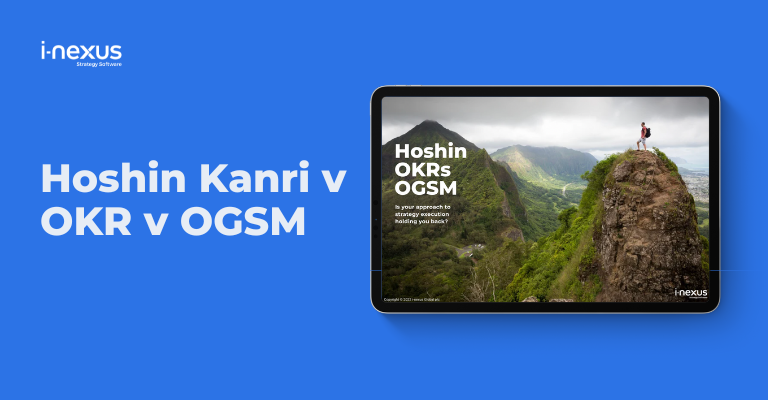Are there any differences between the three prominent strategy deployment methodologies of OGSM, OKR, and Hoshin Kanri? Find out the answers to what OKR stands for, when to apply Hoshin Kanri, and more.
Written by: Christian Loyer, Managing Director, Loyer Consulting Ltd, and James Milsom
Despite strategy deployment methodologies being around for a while, it is only in the last few years we have heard about specific forms such as OGSM, OKR, and Hoshin Kanri when we speak of the most successful strategy executioners.
But why this resurgence on strategy deployment methodologies? And what are the differences between the dominant players?
Well, we at i-nexus are ideally positioned to answer this question as we deal with organizations who have the same goal: to deploy their strategy in a much more disciplined way.
After all, why invest so much in defining an amazing strategy with an army of consultants, off-site meetings at exotic locations, for that strategy to remain unexecuted?
Read on to learn why the core differences in delivering strategy could boil down to terminology, and what makes each methodology.
Hoshin Kanri
What are the origins of Hoshin Kanri?
To begin, the most robust and complete methodology in the market today (according to many practitioners); Hoshin Kanri, has been around since the 1950s.
Who invented Hoshin Kanri?
The founding author of Hoshin Kanri is Dr Yoji Akao.

Credit: Lean Strategies International
He developed Hoshin after creating the Quality Function Deployment (QFD) / House of Quality, a tool that helps organizations improve their decision-making.
All of a sudden, Hoshin Kanri helped Japanese organizations think top-down in a more structured way, rather than only bottom-up with their production systems (Lean in today's language).
Manufacturing organizations across Japan and the US were early adopters of this new Hoshin Kanri approach, but today this extends to the likes of HP, Xerox, and AT&T.
What does Hoshin Kanri mean?
An essential part of the Lean methodology, translated from Japanese, Hoshin Kanri means:
Direction (Ho) + Needle (shin) = 方針
Control (Kan) + Reason (ri) = 管理
.png?width=678&name=Webinar%20Banners%20(31).png)
Advantages of Hoshin Kanri
- Top-down x bottom-up: Hoshin Kanri involves planning at the top and bottom, using catchball to engage teams in agreeing the goals and work necessary to drive reaching the True North.
- Horizons: Hoshin encourages you to set plans on a long, medium, and short term basis, ensuring you can review and adapt direction at the appropriate time, and revisit your assumptions.
- Simplicity: If everyone is using the same five tools, such as the X- Matrix, Action Plan, and Bowling Chart, it is easier to adopt and deliver on your framework.
- Data: Centrally managing Hoshin means that all performance data is poured into one location, meaning review meetings are driven by fact, not fiction.
Disadvantages of Hoshin Kanri
- Admin: Hoshin typically begins to slow down in momentum when the burden of managing Hoshin in spreadsheets, PowerPoint, and email takes its toll.
- Inconsistencies: There are many templates available for the X-Matrix, Bowling Chart etc. The key is to drive consistency in tools used and enforce best practices to maintain execution.
- Disconnects: As the x-matrix is built, cracks can show in the strength of your plan, such as improvement priorities and annual plans being disconnected from Breakthroughs.
- Misuse: The Bowling Chart should be used for finding and overcoming blockers, not punishing missed targets. Using countermeasures can overcome this.
OKR
What is OKR?
OKR is a goal management approach designed to align your team and drive engagement of your strategy via measurable, meaningful goals. OKRs should not be confused with traditional KPIs. OKRs are about fast-paced delivery of objectives and regularly tracking results.
Who invented OKR?
Founded by Andy Grove, OKRs came to prominence in the late 1990s.
It was there that a small company known as Google adopted the thinking and vernacular through John Doerr, the renowned ‘Godfather’ of OKR.
What does OKR stand for?
OKR stands for:
- Objectives
- Key
- Results
Which companies use OKR?
OKR is adopted by a large number of organizations based in technology and software, including Airbnb, Google, Netflix, and Viacom.
Advantages of OKRs
- Engagement: Objectives and results flow from the corporate level, to functional, to each and every member of your team for improved engagement in your plans.
- Communication: A key driver in the gap between your strategy and its execution is communication. OKRs shield your team from distraction, and boosts collaboration.
- Accountability: OKRs help your organization move away from a picture of misunderstanding of direction, empowering your team to set their own goals, linked to your objectives.
- Pace: Being able to adapt and react to the ever-changing world is
crucial to your strategy's delivery. With OKRs you are encouraged to set objectives on a quarterly cycle.
Disadvantages of OKRs
- Achievable: Given the quarterly cycle, OKRs are naturally not transformational in nature. If stretch goals are wanted, set
the OKR beyond this time frame. Be aspirational. - Tribal: A goal in one area could be reliant on another - if your teams are not encouraged to collaborate, the OKR will be
failed, therefore culture hack past-tribal mentalities. - Hollow: If you set OKRs which do not link back to what matters -
your customer - and improving their experience, these OKRs are vanity projects, with little value. - Specificity: A common obstacle is how specific the OKR should be. Remember, OKRs are about what you are trying to achieve, not how you will deliver on that objective.
OGSM
What is an OGSM?
OGSM in the strategic planning world is around defining what your organization wants to achieve, and how you will get there. It is applied during the strategic planning process and ensures clear goals and ownership in ensuring your business acts on its strategic choices and delivers mission-critical goals.
Who created OGSM?
Following World War Two, OGSM began to take root in 1950s Japan out of Peter Drucker's MBO method (Management by Objectives).
What does OGSM stand for?
OGSM stands for:
- Objectives
- Goals
- Strategies
- Measures
What companies use OGSM?
Initially developed and brought to prominence by Procter & Gamble, and then car manufacturers, today its adopters are cross-industry, including Coca-Cola, Honda, and MetLife.
Advantages of OGSM
- Visibility: Thanks to the streamlined approach, OGSM allows you to create a short, concise one-page plan that can be picked up and understood across the entire organization.
- Commonality: Too often strategies are set, far removed from the organization. OGSM begins with the end in mind, so the Cx down to team members are involved in creating an OGSM that unifies every person and workstream.
- Action: The spirit of OGSM is to take strategies and create actions. Every goal is linked to a specific action, which is then measured, creating rigor around executing and measuring performance that links to the common goal.
Disadvantages of OGSM
- Leadership: OGSM should be seen as a prioritization tool - helping you to know the work to focus on. There are many priorities to address in every organization, so leaders must be aligned on focus for OGSM to work.
- Reviews: We are taught to review on an annual basis, but with OGSM a monthly, quarterly, and annual review becomes a commonplace - ensure your organization understands and sees the value of this regularity
- Detail: Whether spending too much time writing the strategy or believing everyone needs an OGSM rather than linking OGSM to performance measurements, avoid too much time on defining, and instead focus on execution.
Methodologies to turn strategy into actionable projects
“In the majority of cases – we estimate 70% - the problem isn’t bad strategy but…bad execution.” Fortune Magazine
Executing strategy is hard. Where do you start? How do you do it? How do we break down the vision into objectives and then into projects?
Enter Hoshin Kanri (also sometimes called Policy Deployment), OGSM and OKR - not to mention other methodologies. Those methodologies are there to help organizations break down their strategy into actionable projects.
In this article, I want to answer one of the more frequent questions we get asked when presenting Hoshin Kanri at conferences, webinars and seminars: what’s the difference between the methodologies?
Same book but different page – methodologies to execute strategy
At their core, strategy methodologies all aim to achieve the same outcome: help organizations execute their strategy. The main difference is they use different languages and drill down to varying degrees.
Here’s what that can look like from an OKR vs. Hoshin Kanri vs. OGSM perspective.
Visualizing the Objectives and Key Results (OKR) methodology
With OKR you drill down only from the objective level through to its key results:

Drilling down with the Hoshin Kanri methodology
Unlike OKR, with Hoshin Kanri there is, in theory, no limit to your drill down:
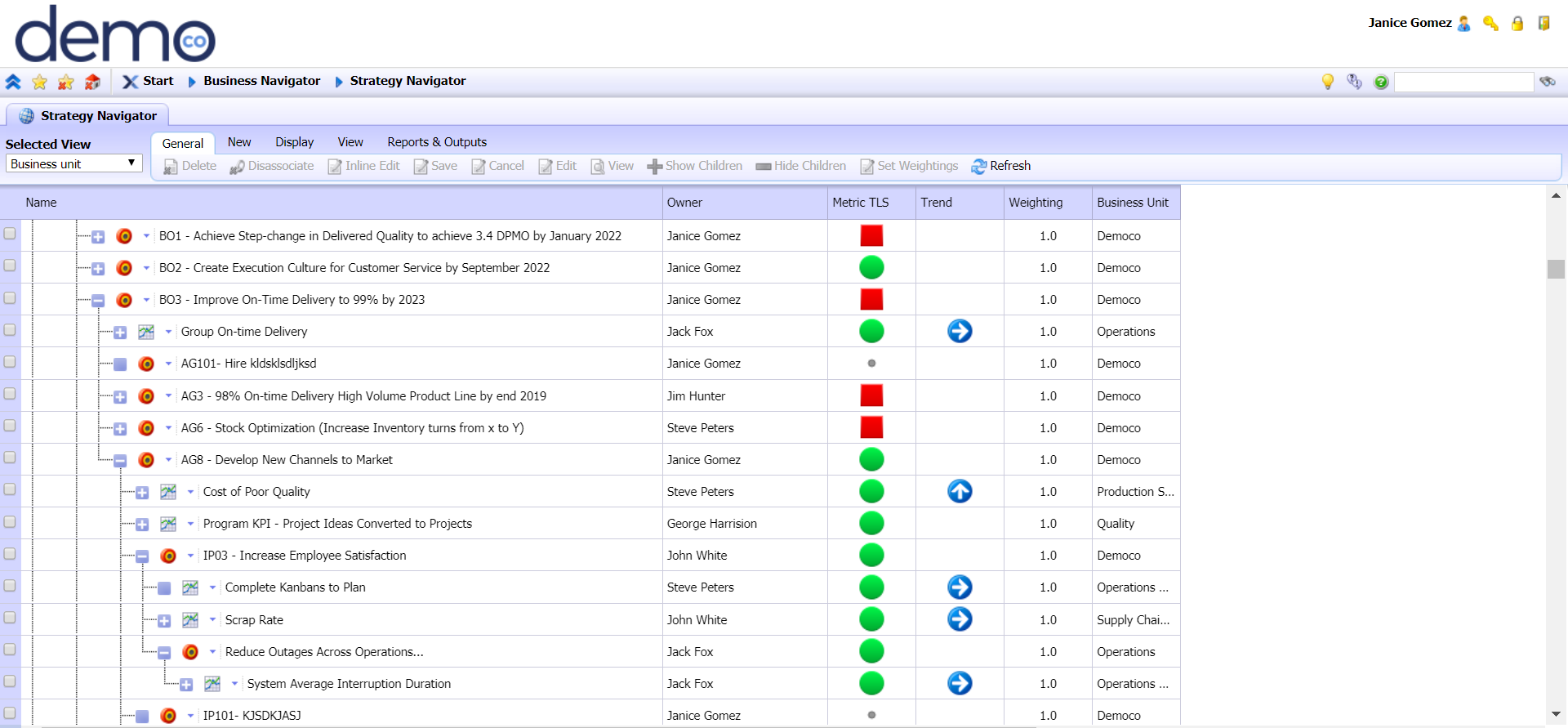
In this screen from our i-nexus strategy execution software, you can see that Breakthrough Objective 3 (BO3) has been broken down into Annual Goals and if we expand Annual Goal 8 (AG8), it has a subset of Improvement Priorities (IPs) which could be broken into further sub-objectives and projects.
Here, IP03 has two metrics associated with it and a further sub-objective.
This cascade can (but does not need to be) be endless, helping you drill down to very specific actionable items of work.
This cascade can be represented in an X Matrix format as well (it's easy to switch from a causal tree to X matrix view in i-nexus:

For the sake of convenience, I have highlighted in green the route I presented to you earlier: BO3 > AG8 > IP03.
Presenting your Objectives, Goals, Strategies & Measures (OGSM) methodology
As for OGSM, the breakdown is also quite infinite but uses a more visual cascade typically in a PowerPoint presentation where the head of a function, let’s say the SVP of Supply Chain Global, will present its OGSM:
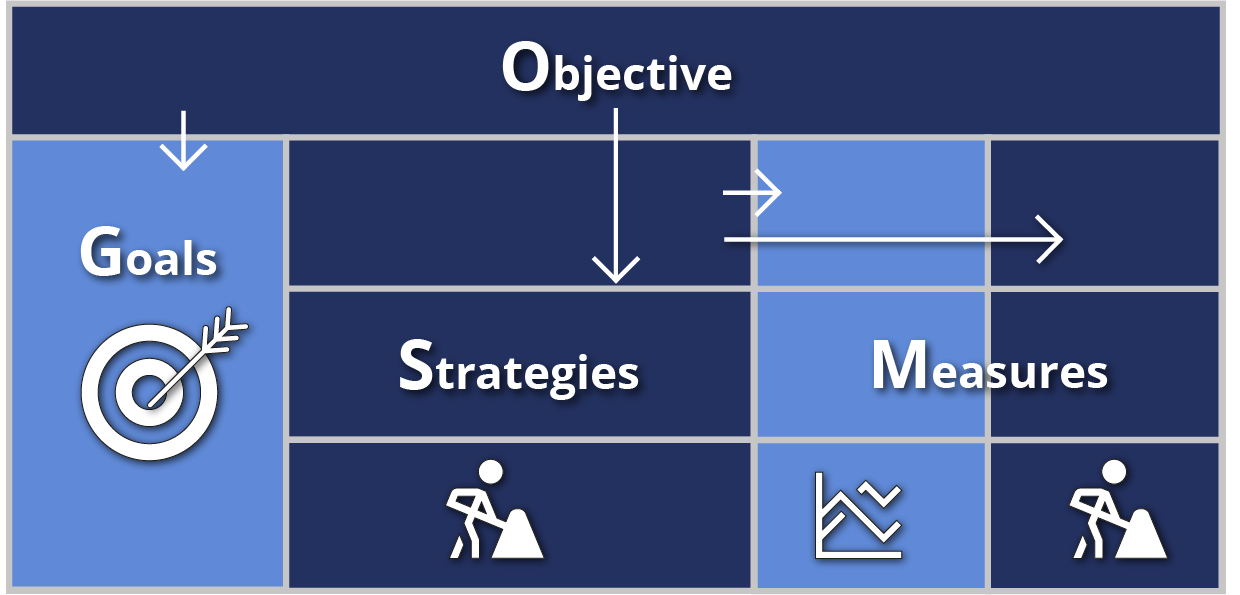
From this OGSM, direct reports to the SVP of Supply Chain Global, such as the regional VPs, will create their OGSM.
In turn, the country Supply Chain Directors will create their OGSM and then the Plant Managers will do the same.
The result is a massive PowerPoint deck that tries to capture the cascade of objectives.
This is what an OGSM would look like in PowerPoint:
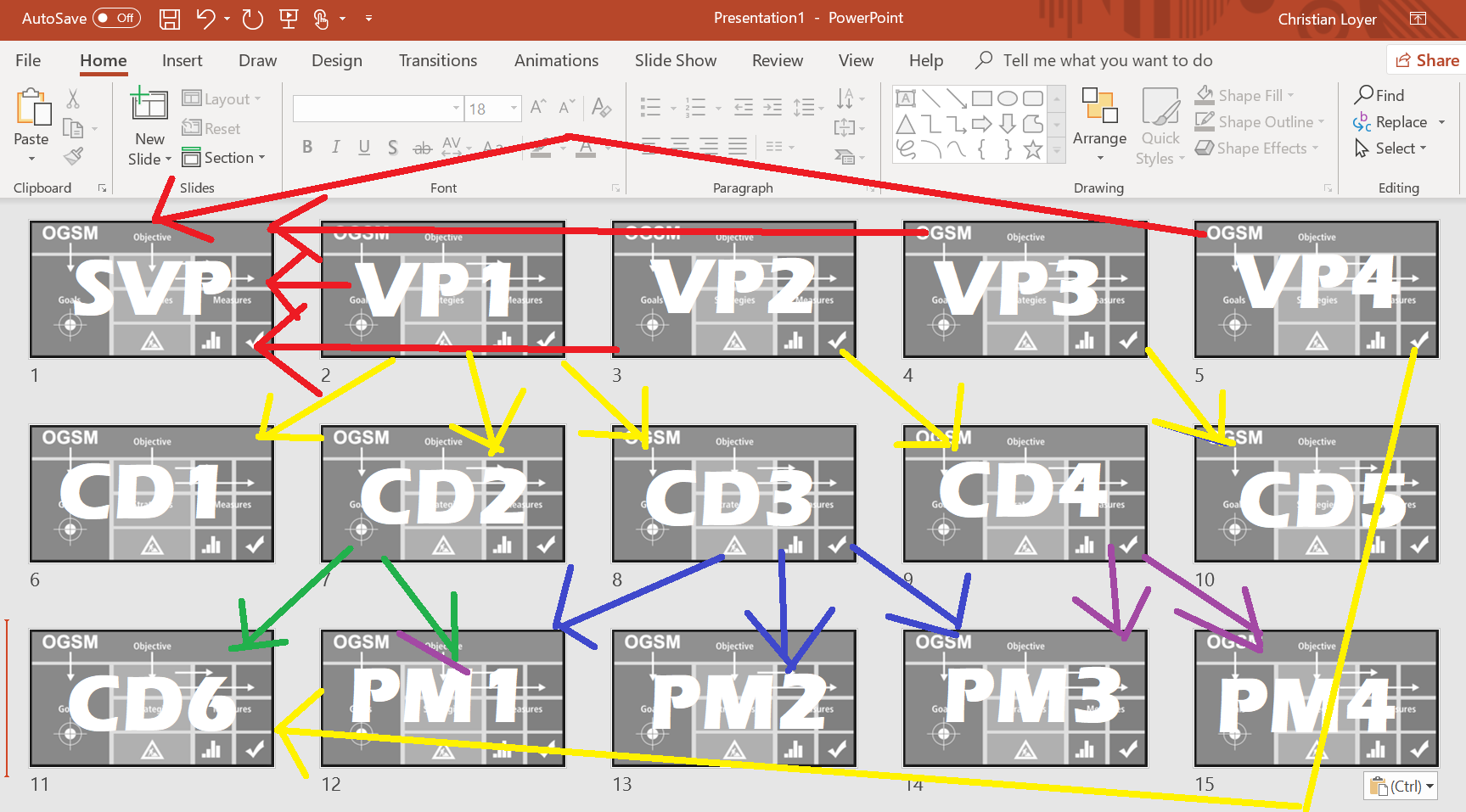
The arrows are there to give you a feel of how the different OGSM connect, not that this would be visible in a deck, you would have to figure this by yourself.
Apples and oranges? A top-line comparison of strategy methodology
My objective with this blog was not to give you a summary of the advantages or disadvantages of each methodology, but to answer the question: what is the difference between them?
Well, first, let me say this is like comparing languages.
At first glance, the words ‘good day’ and ‘bonjour’ look very different from each other, but if one speaks both English and French, one knows it means the same thing.
The same is very true with strategy deployment methodologies: they all use a different language.
For example in Hoshin Kanri, the vision is very often referred to as ‘True North’.
Also true are strategies being referred to as ‘Initiatives’ in OGSM or ‘To-dos’ in OKR. And even that is not standard terminology; we have Hoshin Kanri clients who don’t use the terminology ‘True North’ as per its inventor, opting instead to use ‘Vision’ or even ‘Mission’.
Compare and contrast table
In the table below I have made the best attempt at comparing each level and aspects of the various methodologies:
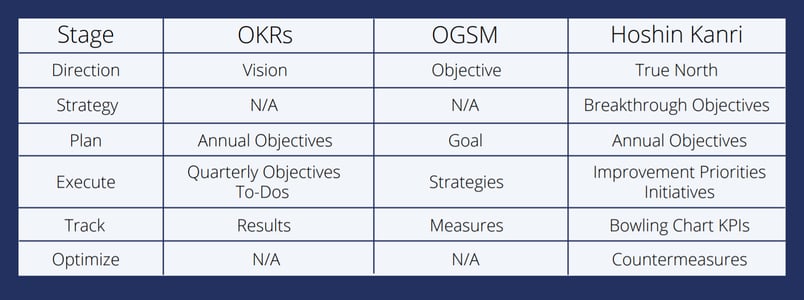
Note that the OKR cycle is not annual as Hoshin Kanri and OGSM, but quarterly, and that is why you will not have 3-5 years objectives in OKR.
This is also why Google and other Silicon Valley organizations will favor OKR, whereas Hoshin Kanri is adopted more by the Lean organizations (which I’ll touch upon in a future blog).
In conclusion, the difference is mainly language first and second the rigor that is applied to each methodology. But at the core, they all aim to achieve the same outcome: help organizations deliver on their promises.
Want to learn more?
We have a wealth of free resources to digest, designed to help you achieve your strategic, improvement, or transformational goals. We've hand-picked the below to set you on the right track:
- Why you should use catchball to drive buy-in of your goals: Tweaking your goal cascade with the catchball process helps you to gather feedback, improve quality and improve your chances of success. Here's what you need to know and how to implement it.
- Digitalizing the x-matrix: Watch our on-demand webinar showing you the industry-leading, time-saving, hub-of-all-hoshin i-nexus x-matrix.
- Hoshin Kanri eBook: Your guide to delivering breakthrough goals in your Hoshin deployment.
About the author
Christian is the Managing Director of Loyer Consulting Ltd. With a rich background in the industry, today he uses his 20 years experience to make things more digital for his clients. He helps them to get away from the heavy lifting of executing strategy, managing projects and following-up on KPIs with spreadsheets, PowerPoints and SharePoint sites.
If you’d like to talk more about your strategic challenges, reach out to Christian on LinkedIn for more strategic insights.
